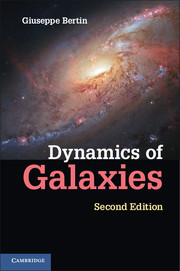Book contents
- Frontmatter
- Contents
- Preface to the Second Edition
- Preface to the First Edition, 2000
- Acknowledgments
- PART I Basic Phenomenology
- PART II Physical Models
- PART III Spiral Galaxies
- PART IV Elliptical Galaxies
- 21 Orbits
- 22 Stellar Dynamical Models
- 23 Stability
- 24 Dark Matter in Elliptical Galaxies
- PART V In Perspective
- Bibliography
- Index of objects
- Index
24 - Dark Matter in Elliptical Galaxies
from PART IV - Elliptical Galaxies
Published online by Cambridge University Press: 05 June 2014
- Frontmatter
- Contents
- Preface to the Second Edition
- Preface to the First Edition, 2000
- Acknowledgments
- PART I Basic Phenomenology
- PART II Physical Models
- PART III Spiral Galaxies
- PART IV Elliptical Galaxies
- 21 Orbits
- 22 Stellar Dynamical Models
- 23 Stability
- 24 Dark Matter in Elliptical Galaxies
- PART V In Perspective
- Bibliography
- Index of objects
- Index
Summary
From the discussion of Chapter 20 it should be clear that spiral galaxies possess significant amounts of dark matter in the form of a diffuse halo. Thus we should naturally expect that elliptical galaxies also possess sizable dark halos. Can we prove the validity of this expectation? How can we measure the amount and distribution of dark matter in elliptical galaxies? Note that in contrast to the case of spirals, we may easily imagine here that the halo has the same spatial distribution as the luminous matter because both components can be thought to be the result of collisionless collapse.
In general, elliptical galaxies lack a straightforward, radially extended kinematic tracer, such as the atomic hydrogen emission used to derive the rotation curves of spiral galaxies. Furthermore, although for spirals we can produce convincing tests to judge the overall spatial symmetry of the underlying gravitational potential, for ellipticals, such symmetry is a major open question not only in general but also especially for individual objects; in particular, it is difficult to determine whether the system is basically axisymmetric or triaxial. Thus it is not surprising to find that the data of many objects can in principle be fitted by models that assume a constant mass-to-light ratio. However, in many cases, models of this type are found to be difficult to justify from the physical point of view; for example, if the velocity-dispersion profile is rather flat, as for NGC 4472, a significant bias of the pressure tensor in the tangential direction would be required.
- Type
- Chapter
- Information
- Dynamics of Galaxies , pp. 370 - 388Publisher: Cambridge University PressPrint publication year: 2014



